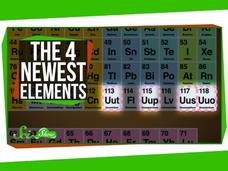MinutePhysics
What is a Dimension? In 3D...and 2D...and 1D
How many dimensions are there? Latitude, longitude, and altitude are accepted dimensions, but what about time or another type of dimension? An engaging video describes how we theorize that we live in three dimensions and which laws of...
MinutePhysics
What is the Wave/Particle Duality? Part 1
Einstein rejected the idea of wave/particle duality, yet now we believe the concept to be true. A short video explains the properties of waves, particles, and the behavior of electrons, which act as both. The film concludes with...
TED-Ed
Oxygen’s Surprisingly Complex Journey Through Your Body
What does digestion have to do with aerobic respiration? Watch a video that explains the processes and systems in our bodies that allow oxygen to travel throughout.
MinutePhysics
Tutorial: Creating the Sound of Hydrogen
How do you create the sound of hydrogen? An interesting video explains how to use mathematical formulas and sound software to translate the spectrum of light that comes from hydrogen into a sound. The resource walks through each...
MinutePhysics
What is the Uncertainty Principle?
What is the Uncertainty Principle? A succinct video describes the uncertainty principle as wave behavior.
MinutePhysics
What is the Wave/Particle Duality? Part 2
Electrons, neutrons, and photons display behavior explained by wave-particle duality. The video explains how to picture the duality of behaviors in these parts of atoms. The drawings and comparisons to the behavior of water focus on...
Fuse School
Barium Meals
How and why barium is used in X-rays is the focus of a video that also describes the similarities with bones, the insolubility, and the medical applications of this element.
Fuse School
Salt and Diet
Salt is necessary for your diet, but too much or too little and it causes health problems. These problems, as well as what salt does in your body, are the focus of a video that also looks at where salt is found in food and how much salt...
Fuse School
Extraction of Salt
The three methods of extracting salt — evaporation of seawater, salt mining, and solution in water — are the focus of an informative video that includes additional interesting details, such as the fact that the word salary is...
Fuse School
Solubility Rules
The rules related to solubility of salts are explained in a video that shows the solubility table that summarizes them and concludes with why this information is important to know.
Fuse School
Making Insoluble Salts
Barium has many applications depending on its form: it can be poisonous, used to color fireworks, or, as in the example in this video, used as contrast in X-ray imaging. The resource that explains how to make and isolate insoluble...
Fuse School
Ammonium Salts and Solutions
The importance of ammonium salt solutions is covered in a video that explains how to solve the reactions, the chemical equations, and the structure of the various ions.
Fuse School
Neutralisation of Alkalis
Alkalis and how to neutralize them through titrations are the focus of a video that also explains why this process is important in a modern society.
Fuse School
Titrations
Cartoon drawings demonstrate the proper way to complete a titration lab. The video includes information about the tools needed, the set up required, and the reason for multiple trials.
Fuse School
Stomach Acid
Approximately 60 million Americans suffer from acid reflux. The video explains why our stomachs have acids, how they work, and how they don't eat through the lining of our stomach. Then it explains what can happen when things go wrong,...
SciShow
The Chemistry of Fried Food
Foods are fried in oils, which are basically a fat that is a liquid at room temperature. Another great video about the chemical reactions in cooking, this one explores frying food. The narrator explains that from the appearance of...
SciShow
How Do Toys Glow in the Dark?
The composition of teeth are such that when exposed to a black light, they absorb the UV light and glow! A radical video explores how different objects glow in the dark. The narrator discusses how different types of chemicals, called...
SciShow
Meet the 4 Newest Elements!
Scientists keep pursuing heavier elements in the hopes of finding a stable and useful element for practical purposes. Hopeful they've found one, the narrator explains the four newest elements that were added to the periodic table in...
SciShow
9 Futuristic Materials
Do invisibility cloaks exist? A cool video features nine materials that seem futuristic but actually exist. From aerogels to invisibility cloaks to unique glass, the narrator discusses each new material and their incredibly...
SciShow
The Deal with Fat
Fats are essential to a balanced diet and help bodies use certain vitamins as well as maintain healthy skin and hair. While watching the video, learners explore fat, which is certainly talked about a lot in terms of health. The narrator...
Crash Course
Respiratory System (Part 2)
Hemoglobin which is red, carries oxygen in RBC, and is responsible for the color of our blood. Video 32 in a series of 47 focuses on how your blood exchanges oxygen and carbon dioxide to maintain homeostasis. Scholars see how hemoglobin...
SciShow
The Quest for Glueballs
"If you think you understand quantum mechanics, you don't understand quantum mechanics." - Richard Feynman. The video describes how our current model of physics predicts glueballs, groups of gluons attached to each other. Gluons have no...
SciShow
Heisenberg Uncertainty Principle
Subatomic particles live in a cloud of probability. The video explains the Heisenberg uncertainty principle and how it relates to this cloud of probability. It also details the observer effect, which is often confused for the uncertainty...
Crash Course
Metabolism and Nutrition (Part 1)
Use the 36th video of 47 to explore metabolism. Individuals begin to understand what metabolism is, physiologically what it does, and how anabolic and catabolic reactions assist in digestion.























